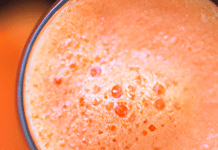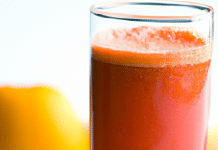Are you tired of feeling confused about whether your juicer is masticating or centrifugal? Well, fret no more, because we’re here to shed light on this topic and arm you with the knowledge you need to discern the difference. Whether you’re a juicing enthusiast or a beginner, understanding the workings of your juicer is essential for getting the best results. In this article, we’ll take you through the key characteristics of both masticating and centrifugal juicers, helping you identify which one you have and harness its benefits to enjoy a refreshing glass of goodness. Get ready to become a juicing pro!
Review contents
Why Does It Matter?
Choosing the right juicer is an important decision for all juice enthusiasts. The type of juicer you use can greatly impact the quality of your juice, as well as your overall juicing experience. When it comes to juicers, the two most common types are masticating juicers and centrifugal juicers. Understanding the differences between these two types of juicers is crucial in order to make an informed decision.
Factors to Consider
Before diving into the specific characteristics and features of masticating and centrifugal juicers, it’s important to consider a few key factors that can influence your decision. These factors include the yield of the juicer, the nutrient content of the juice, the physical characteristics of the juicer, its operating speed, noise level, juicing process, juice quality, shelf life of the juice, cleaning and maintenance requirements, and of course, the price range. By considering these factors, you can determine which type of juicer is best suited to your individual needs and preferences.
Difference in Yield
The yield, or the amount of juice extracted from a certain amount of produce, can vary between masticating and centrifugal juicers. Masticating juicers are known to have a higher yield compared to centrifugal juicers. This is because masticating juicers use a slow and thorough crushing and squeezing action to extract juice, ensuring that every last drop is extracted from the produce. On the other hand, centrifugal juicers use a spinning motion to separate the juice from the pulp, which may lead to a slightly lower yield.
Difference in Nutrient Content
Another important factor to consider when choosing a juicer is the nutrient content of the juice it produces. Masticating juicers are often considered to be superior in this regard. The slow juicing process of masticating juicers helps preserve the natural enzymes and nutrients in the juice by minimizing oxidation and heat generation. In contrast, the high-speed juicing process of centrifugal juicers can generate more heat and introduce more oxygen into the juice, potentially leading to a slight decrease in nutrient content.
Physical Characteristics
Size and Shape
Masticating and centrifugal juicers typically differ in size and shape. Masticating juicers tend to be larger and bulkier due to their more complex internal mechanisms. They often have a horizontal or vertical design, which can take up more counter space in your kitchen. On the other hand, centrifugal juicers are generally more compact and have a vertical design, making them easier to store and transport.
Weight
The weight of a juicer can also vary depending on its type. Masticating juicers are generally heavier due to their larger size and more robust construction materials. This weight can make them less portable and more difficult to move around. Centrifugal juicers, being smaller and lighter, are more convenient for those who prioritize portability and easy handling.
Construction Materials
The construction materials used in masticating and centrifugal juicers can differ as well. Masticating juicers are often made of heavy-duty materials such as stainless steel, which contribute to their durability and longevity. Centrifugal juicers, on the other hand, tend to be made of lightweight and less durable materials such as plastic. This difference in construction materials can impact the overall quality and lifespan of the juicer.
Feeding Mechanism
The feeding mechanism, or how you insert the produce into the juicer, can vary between masticating and centrifugal juicers. Masticating juicers usually have a narrow chute and require the produce to be cut into smaller pieces before juicing. This can be more time-consuming, but it allows for a more controlled and efficient juicing process. Centrifugal juicers, on the other hand, typically have a wide feeding chute that can accommodate larger chunks of produce, reducing the preparation time but potentially sacrificing the precision of the juicing process.
This image is property of images.prismic.io.
Operating Speed
Low Speeds for Masticating Juicers
One of the key characteristics of masticating juicers is their slow operating speed. Masticating juicers operate at a low speed of around 80 RPM (Rotations Per Minute) or lower. This slow speed ensures a gentle and thorough juicing process, minimizing heat and oxidation. The slow speed also prevents foaming, frothing, and excessive pulp in the juice, resulting in a smoother and more consistent juice texture.
High Speeds for Centrifugal Juicers
In contrast, centrifugal juicers are designed to operate at high speeds. These juicers can reach speeds of up to 12,000 RPM or more. The high-speed spinning motion of the centrifugal juicer allows for a quick and efficient juicing process, extracting juice from the produce in a matter of seconds. However, the high speeds can lead to more heat and oxidation, potentially impacting the nutrient content and overall quality of the juice.
Noise Level
Generally Quieter: Masticating Juicers
When it comes to noise level, masticating juicers tend to be quieter compared to centrifugal juicers. The slow and steady operation of masticating juicers produces less noise, allowing for a more peaceful juicing experience. This is particularly beneficial if you prefer juicing in the early morning or late at night when noise levels need to be kept to a minimum.
Louder: Centrifugal Juicers
On the other hand, centrifugal juicers are known to be louder due to their high-speed operation. The powerful motor and spinning blades can create a significant amount of noise during the juicing process. If you live in a shared space or have sensitive ears, you may want to consider the noise level of the juicer before making a decision.
This image is property of images.prismic.io.
Juicing Process
Step-by-Step Guide for Masticating Juicers
Using a masticating juicer involves a series of steps to ensure proper juicing. Here is a step-by-step guide:
- Prepare the produce by washing it thoroughly.
- Cut the produce into smaller pieces that can fit into the narrow chute of the juicer.
- Turn on the juicer and slowly feed the produce into the chute.
- Allow the juicer to work its magic, as it slowly crushes and squeezes the produce to extract the juice.
- Collect the juice in a container and enjoy!
Step-by-Step Guide for Centrifugal Juicers
Using a centrifugal juicer is a relatively simple process. Here’s a step-by-step guide:
- Wash the produce to remove any dirt or debris.
- Cut the produce into larger chunks that can easily fit into the wide feeding chute of the juicer.
- Turn on the juicer and steadily feed the produce into the chute.
- Watch as the centrifugal force separates the juice from the pulp, sending the juice into one container and the pulp into another.
- Pour the juice into a glass or container and savor the taste!
Juice Quality
Oxidation and Heat Generation
The quality of the juice can be influenced by factors such as oxidation and heat generation during the juicing process. Masticating juicers, with their slow and gentle operation, minimize oxidation and heat generation. This helps to retain the natural enzymes and nutrients in the juice, resulting in a higher quality juice with a fresher taste. Centrifugal juicers, due to their high-speed operation, can generate more heat and introduce more oxygen into the juice, potentially leading to a slightly lower quality and shorter shelf life.
Pulp Content
Masticating and centrifugal juicers differ in the amount of pulp they extract from the produce. Masticating juicers tend to produce juice with less pulp, resulting in a smoother texture and more refined taste. This is because the slow and thorough crushing action of masticating juicers effectively separates the juice from the pulp. Centrifugal juicers, on the other hand, may allow more pulp to pass through, resulting in a juice with a slightly thicker consistency and more noticeable pulp.
Texture and Consistency
The texture and consistency of the juice can also vary between masticating and centrifugal juicers. Masticating juicers tend to produce juice with a thicker and more velvety texture. This is due to the slow and comprehensive extraction process, which ensures that all the juice is thoroughly squeezed out from the produce. On the other hand, centrifugal juicers may produce a juice with a lighter and frothier texture, which some people prefer.
This image is property of juicernet.com.
Juice Shelf Life
Longer Shelf Life: Masticating Juicers
The shelf life of the juice can play a significant role in determining which type of juicer is right for you. Masticating juicers are known to produce juice with a longer shelf life compared to centrifugal juicers. The slow juicing process of masticating juicers minimizes oxidation, which helps to preserve the natural freshness and quality of the juice for a longer period of time. This means that you can store your juice for a few days without worrying about it losing its nutritional value and taste.
Shorter Shelf Life: Centrifugal Juicers
In contrast, the high-speed operation of centrifugal juicers can lead to increased oxidation, resulting in a shorter shelf life for the juice. The introduction of more oxygen and the generation of heat during the juicing process can cause the juice to degrade more quickly. If you prefer to consume your juice immediately or within a day or two, the shorter shelf life of centrifugal juicers may not be a significant concern for you.
Cleaning and Maintenance
Ease of Cleaning
Cleaning and maintaining your juicer is an essential part of the juicing process. Masticating juicers are often considered to be easier to clean compared to centrifugal juicers. The slow and deliberate juicing process of masticating juicers typically results in less pulp clogging the machine, making it easier to disassemble and clean. Centrifugal juicers, due to their high-speed operation, can produce more pulp and require more thorough cleaning to ensure all parts are free of residue.
Time and Effort Required
The time and effort required for cleaning and maintenance can vary between masticating and centrifugal juicers. Masticating juicers usually have more parts to clean and disassemble, which can take a bit more time compared to centrifugal juicers. However, the slower and controlled operation of masticating juicers typically means that less pulp and residue accumulate, resulting in a more efficient cleaning process overall.
Durability and Longevity
Another aspect to consider when it comes to cleaning and maintenance is the durability and longevity of the juicer. Masticating juicers, made of heavy-duty materials such as stainless steel, are generally more durable and long-lasting. They can withstand frequent use and rigorous cleaning without compromising performance. Centrifugal juicers, being made of lighter materials such as plastic, may not be as durable and may require more frequent maintenance or replacement of parts.
This image is property of images.prismic.io.
Price Range
Wide Price Range for Masticating Juicers
When it comes to price, masticating juicers typically offer a wider range of options compared to centrifugal juicers. Masticating juicers are available in a variety of price points, ranging from affordable entry-level models to high-end professional-grade juicers. The price of a masticating juicer often reflects its quality, durability, and additional features such as multiple juicing screens or attachments.
Affordability and Availability of Centrifugal Juicers
On the other hand, centrifugal juicers are generally more affordable and widely available in the market. Their simpler design and construction materials contribute to a lower price point, making them a popular choice for those who are on a budget or new to juicing. Centrifugal juicers are widely available in most department stores, appliance stores, and online retailers, allowing for easy accessibility and comparison shopping.
Popular Brands and Models
Masticating Juicer Brands and Models
There are several reputable brands that offer masticating juicers. Some popular brands include Omega, Tribest, Hurom, and Kuvings. Within each brand, there are various models to choose from, each offering different features, capacities, and price points. Some highly recommended masticating juicer models include the Omega NC900HDC, Tribest GSE-5050 Greenstar Elite, and Hurom H-AA Slow Juicer.
Centrifugal Juicer Brands and Models
There are also numerous brands that specialize in centrifugal juicers. Breville and Cuisinart are two well-known brands that offer a wide range of centrifugal juicer models. Breville Juice Fountain series, such as the Breville Juice Fountain Elite and Breville Juice Fountain Plus, are highly regarded among juice enthusiasts. Cuisinart’s CJE-1000 Juice Extractor is another popular centrifugal juicer model known for its performance and affordability.
In conclusion, choosing between a masticating juicer and a centrifugal juicer requires careful consideration of various factors such as yield, nutrient content, physical characteristics, operating speed, noise level, juicing process, juice quality, shelf life, cleaning and maintenance, price range, and popular brands/models. By taking into account your personal preferences, lifestyle, and specific juicing needs, you can make an informed decision and find the perfect juicer that will bring joy and deliciousness to your daily juicing journey.
This image is property of embed.filekitcdn.com.




































